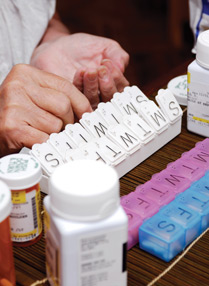FDA asks clinicians to limit prescriptions of acetaminophen
The FDA recommends that clinicians stop prescribing and dispensing combination drugs that contain more than 325 mg of acetaminophen per dose.
Some prescription and over-the-counter pain relievers pack enough acetaminophen to seriously harm patients, and trying to control the issue is giving some at the FDA a headache. The agency has come up with a remedy of its own, and it may affect how doctors prescribe.
The FDA recommended on Jan. 14 that clinicians stop prescribing and dispensing combination drugs that contain more than 325 mg of acetaminophen per dosage unit. The FDA also urged pharmacists who receive prescriptions for higher doses to contact prescribers to discuss a lower dose.

The recommendation comes 3 years after the FDA asked manufacturers to limit the amount of acetaminophen in prescription combination drugs to 325 mg, with a deadline of January 2014. Although many manufacturers have voluntarily complied with the request, others continue to produce combination prescription drugs that contain higher doses. The FDA has stated that it intends to start proceedings to withdraw approval of these medications.
Combination drugs containing acetaminophen and opioids such as oxycodone or hydrocodone are often prescribed for postsurgical or chronic pain on a “take-2” basis, which would provide 650 mg of acetaminophen at a time. Whether patients could derive more benefit from doses of acetaminophen higher than 650 mg at a time depends on the person one asks.
“The manufacturers claim there are additional benefits in going from 650 mg to 1,000 mg, but the evidence is not convincing,” said Barton Cobert, MD, FACP, adjunct associate professor at Rutgers University in Newark, N.J., and president of BLCMD Associates LLC in Chapel Hill, N.C., which offers consulting services in drug safety.
In its Jan. 14 recommendation, the FDA noted that there are currently no data to suggest that doses higher than 325 mg offer any therapeutic benefits and stressed that inadvertent overdoses of acetaminophen can result in liver failure or death.
Therapeutic misadventure
Acetaminophen's effects on the liver have been scrutinized for decades, with the first reports of liver toxicity due to acetaminophen overdose appearing in the Aug. 27, 1966, British Medical Journal. Since then, a considerable body of evidence has come to suggest that although the drug carries little risk in small doses, the hepatic risks of overdosing are very real. Data from the U.S. Acute Liver Failure Study Group point to acetaminophen poisoning as the culprit behind half of the nation's cases of acute liver failure. Unintentional overdoses account for 48% of acetaminophen-related acute liver failure. In that population, 38% of patients were simultaneously taking more than 1 acetaminophen-containing drug and 62% were taking an opioid-acetaminophen combination.
“Acetaminophen has been advertised over the years as highly safe, but at high doses, it's not. A dose of 12 to 16 grams [in a day] will kill about 50% of people,” said William M. Lee, MD, FACP, professor of internal medicine at the University of Texas Southwestern Medical School and researcher in the U.S. Acute Liver Failure Study Group.
Other research bears out the potentially lethal consequences of acetaminophen overdose. Data from the National Hospital Ambulatory Medical Care Survey (NHAMCS) and the National Electronic Injury Surveillance System (NEISS) suggest that acetaminophen overdose is responsible for between 44,378 and 78,414 emergency department visits in the U.S. each year. Data from the National Hospital Discharge Survey (NHDS) indicate that each year acetaminophen overdose results in 33,520 hospitalizations. Although a majority of these overdoses were intentional, as in attempted suicide—50% in NHAMCS, 69.8% in NEISS, and 74.2% in NHDS—that still leaves a notable percentage of accidental overdoses.
It is not difficult for patients who take combination prescription drugs that contain oxycodone or hydrocodone to overdose on acetaminophen, said Dr. Lee. “Patients can become habituated to opioids, and when you start to crank up the dose beyond 4 or 8 per day to 12 per day, you're bringing all of that acetaminophen along with it.”
Indeed, in the November 2011 Drug Safety, researchers published a study examining the prescription data of 4.8 million beneficiaries in a U.S. health benefits organization in 2009. The team found that 8.1% of 5.3 million prescriptions for opioid-acetaminophen combination drugs exceeded the recommended maximum daily dose of acetaminophen.
“Physicians should be aware of the addictive potential of opioids, remember that acetaminophen poisoning is dose-related, and avoid overprescribing,” said Dr. Lee.
Marcus M. Reidenberg, MD, FACP, professor of pharmacology, medicine, and public health at Weill Cornell Medical College in New York, advised physicians to consider alternative medications or prescribing habits to help their patients avoid accidental acetaminophen overdoses.
“If one combination drug becomes inadequate for pain, pick another, instead of just continually raising the daily dose,” Dr. Reidenberg said. “For patients with complex therapeutic issues, prescribe single agents separately. It may be more inconvenient for the patient, but it's safer from a pharmacological standpoint because you have better control over the doses.”
OTC acetaminophen counts, too
According to the National Council on Patient Information and Education, more than 600 prescription and over-the-counter (OTC) products contain acetaminophen, including pain relievers, fever reducers, sleep aids, cough and cold medications, and allergy medications.
With so many products to choose from, patients may not be aware of which OTC products contain acetaminophen. In a survey of 284 patients published in the July-August 2010 Journal of the American Pharmacists Association, two-thirds of the respondents reported current or recent use of pain, cold, or allergy medication, but of those, only 25% knew the active ingredient. Roughly 46% of all respondents knew that “acetaminophen” was synonymous with its brand name, “Tylenol,” but only 12% knew that “APAP” meant acetaminophen. Twelve percent believed that it was difficult or impossible to take a harmful amount of acetaminophen. Only 33% of respondents accurately identified the maximum daily dose, 12% were unsure of the maximum, 10% reported that the maximum was a dose greater than 4 grams, and 7% were unsure whether a maximum dose existed.
Unfamiliarity with labeling indicates a need for education, as it suggests that patients may not be aware of the possibility of taking OTC acetaminophen and prescription acetaminophen at the same time, said Dr. Lee.
“Clinicians know what ‘APAP’ means, but they don't realize that the patients have no idea. They need to talk to their patients about what to look for on the label,” Dr. Lee said.
Dr. Cobert added that a careful discussion with patients about their OTC purchasing habits can help physicians determine risk for inadvertent acetaminophen overdose.
“Ask patients what size bottle they buy and where they get it. If they say they buy their acetaminophen in a big bottle at Costco or have a coupon from CVS and keep a couple of bottles of 500-mg tablets in the cabinet, that could be a red flag,” Dr. Cobert said. “You might need to be clear and say they should only take one pain medication at a time unless they talk to a health care professional.”
For now, the FDA has focused on prescription products, and whether it will attempt to limit OTC preparations to 325 mg per unit remains to be seen. In the meantime, the onus is on prescribers to help their patients understand which products contain acetaminophen and what the maximum recommended daily dose is, said Dr. Reidenberg.
“The important thing to remember is never to take more than 4 grams per day,” he said. “Patients need to understand all the trade names for acetaminophen, and they need to do the math.”




